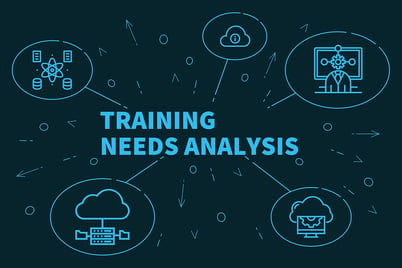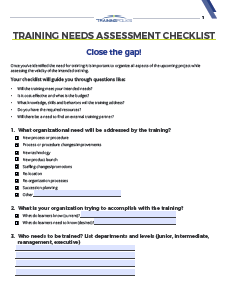Create Training That Works: Three Levels of Training Needs Assessment

Have you ever felt like your company or team is missing something? You might not realize what that ‘something' is at first, but a training needs assessment (TNA) can help. A TNA is a critical step to assess the skills your organization needs, identify gaps between those skills and what training is required.
A Training Needs Assessment is the process to determine what an organization or individual needs in training. This could be anything from technical skills to soft skills. Training needs analysis is a process, not a product. There are three levels of training needs assessment.
Three Levels of Training Needs Assessment
Organizational Level
This level is primarily focused on determining the readiness of the organization to embrace learning and development as part of their organization’s activities. This assessment includes an analysis of the organizational goals and objectives of the company, how it trains and rewards its’ employees, and how it structures its learning to help employees develop skills and behaviors needed to help the organization succeed. Best practices are often used as measurements depending on the type of organization or the depth of learning and development intended to be embedded in the organization as a whole.
The next level of TNA is focused on the content and delivery of your learning requirements from onboarding new employees, through performance development and into innovation or new skills acquisition.
Role Level
This assessment looks at the knowledge, skills and behaviors needed for someone in a role to succeed. It concentrates on the training needed to help an employee succeed in three key areas of performance: hard skills such as system operation or sales, business acumen skills such as critical thinking, data analysis, or financial reporting, and human behavior skills (often referred to as ‘soft skills’) including relationship management, leadership, or emotional intelligence.
The training needs assessment looks at courses and content already available to the employee in role, suggests gaps that will help to fill needed skills, and assessment strategies to encourage uptake and foster development through performance management.
Individual Course or Training topic level
This assessment looks at individual courses or topics (for example, sales, onboarding, Salesforce system training) and analyzes for successes, gaps, and misses in the content, deployment, or assessment of the training itself. It takes into account the persona of the individuals taking the training and their preferred methods of learning and communicating.
In a course or topic assessment, a professional instructional designer will ensure that learning objectives are clear, testable, and have content matching the objectives and test items. They might also suggest or recommend alternative ways of delivering the content to make it easier on the employee, facilitator, or organization.
For example, if a course needs to make sure all of its employees are trained on a particular software, a professional instructional designer will look at the software, the learning objectives that determine performance success, and the content in the existing training and map the easiest path to successful learning and demonstration of the software mastery. They might recommend several methods to deliver that training and testing as well.
Benefits
1. Benefits to the Organization
Knowing your training needs before training will benefit your organization in several ways. First, a training needs assessment forces you to take a hard look at your workplace culture and whether it is ready to put learning and development into key initiatives. Analysis of the organization’s priorities will help determine the budgetary requirements of making learning and development a priority.
Second, in understanding where the biggest gaps and opportunities lie, prioritization of the easiest and most cost-effective training interventions can bring a lot of success to the adoption of a learning and development perspective. With a full organizational analysis, the organization will be able to see where similarities exist across business areas, and you can capitalize on building training interventions once and then deploying them across multiple areas. Good budgeting and planning are an important aspect of realizing the benefits of an organizational training analysis.
Finally, an organizational training needs assessment will help with maintaining development plans for the whole business, using and training skills cross-functionally to create a more adaptable and flexible workforce. This will allow the organization to prioritize and pivot in key functions to encourage growth, manage costs, and build resilience in the organization.
2. Benefits to the department, area, or functional business unit
In analyzing key behaviors, skills, and knowledge necessary to successfully operate a business or role, business units have a way of measuring success of all employees within that area in a consistent manner that will encourage successful performance. Consistency is good for customer experience, performance management, and documentation of work. Consistency allows business units to better predict when something is working and when it is time to change or adapt.
For managers, this consistent skills and knowledge development can also help ease the burden of performance management, compensation, and coaching because they will have a standard to help them determine what “good” looks like all the time. Exceptionalities can be managed as needed and not as normal.
For employees, this consistency will help them to perform at optimal levels and manage their own time and knowledge to bring peace of mind, understanding of where more help or training might be needed, and an expectation for clear development paths to keep them interested and succeeding in their jobs.
3. Benefits to the Individual Employee
The benefits of a training needs assessment can also be seen as a win for the employee. Everyone wins when employees are trained and able to reach their goals. The success of an employee, and the company as a whole, should be everyone's goal.
When to do a training needs analysis
Preparing for Growth
A good training needs assessment will help you prepare for growth in your organization. If you are unaware of current skills, what people currently lack, and where you see the need to grow in the future, it could be a challenge to meet your goals. A TNA provides a starting point for understanding where you need to work on skills and what you need to do to grow knowledge and skill at an organizational, business unit, or individual role level.
Helping Employees Reach goals
One of the major reasons organizations performs a training needs assessment is that they want their employees to reach their goals, but they can’t see how to make that happen. The organization wants its employees, to feel successful and valued in their jobs. Employees who feel successful are more likely to stay with the company, and often act as an advocate.
Cross training or increasing organizational agility will help with growth
A good TNA will help you identify the skills and knowledge your employees need to reach their goals. Once identified, they can be worked on through a combination of different training methods and experiences such as workshops, job shadowing, or seminars. With training, employees can also be taught other skills to help other employees when there is a gap in a functional area. This will help the organization remain agile and flexible in times of growth or change. A TNA is crucial in maintaining a healthy work environment and to help your employees grow, both within the organization and personally.
Summary
A Training Needs Assessment, whether done at the organizational, department, or individual content area level, can provide valuable insight into the gaps and specific opportunities to further develop and enhance skills, knowledge, and behaviors. Professional Learning Advisors and Instructional Designers can help to provide the data needed to make quick wins in terms of content or training delivery. The analysis can give the organization real budgetary information to allow decisions around upskilling or cross-training. And can provide individual contributors and managers alike consistent measurable skills to help keep employees, give them something to aim for, and develop a more agile and consistent organization.
Want to get started with your Training Needs Assessment?
Get out FREE Interactive Download: 'Training Needs Assessment Checklist' to get started.


